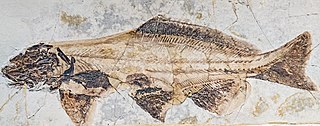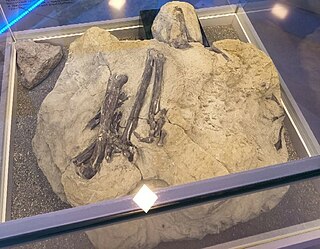
Aralazhdarcho is a genus of azhdarchid pterosaur from the Santonian to the early Campanian stages of the Late Cretaceous period of Bostobe Svita in Kazakhstan. The type and only known species is Aralazhdarcho bostobensis.
The Bostobe Formation is a geological formation in Qaraghandy & Qyzylorda, Kazakhastan whose strata date back to the Late Cretaceous.
The Balabansai Formation is a geological formation in Kazakhstan, Kyrgyzstan and Uzbekistan whose strata date back to the Bathonian and Callovian stages of the Middle Jurassic. Dinosaur remains are among the fossils that have been recovered from the formation. The lithology primarily consists of variegated sandstones, siltstones, claystones, and rare gravels and marls. Many taxa have been found in the formation, including amphibians and mammals.
The Udurchukan Formation is a geological formation located in Amur Region, Far East Russia. Based on palynomorphs such as Wodehouseia spinata, the Udurchukan is considered of Maastrichtian age of the Late Cretaceous, during the Cretaceous Period.
The Lianmuqin Formation, also transcribed as Lianmugin Formation, and Lianmuxin Formation, is an Early Cretaceous geologic formation composed of "interbedded red green and yellow variegated mudstones and siltstones". Dinosaur remains have been recovered from it.
The Ialovachsk or Yalovach Formation is a geologic formation in Kyrgyzstan, Tajikistan and Uzbekistan dating to the Santonian age of the Cretaceous period.

Kileskus is a genus of tyrannosauroid dinosaur known from partial remains found in Middle Jurassic Itat Formation of Sharypovsky District, Krasnoyarsk Krai (Russia). Fossils recovered include the holotype maxilla, a premaxilla, a surangular, and a few bones from the hand and foot. Additional remains referred to the species include cervical and caudal vertebrae, as well as a fibula. The skull bones are similar to those of Proceratosaurus. The type species is K. aristotocus. Kileskus was named in 2010 by Averianov and colleagues. Its size has been estimated at 5.2 meters in length and 700 kg in weight.
The Itat Formation is a geologic formation in western Siberia. It was deposited in the Bajocian to Bathonian ages of the Middle Jurassic. Dinosaur remains are among the fossils that have been recovered from the formation, including the proceratosaurid Kileskus, as well as fish, amphibians, mammals and many other vertebrates. The formation is noted for bearing significant coal reserves, with large open pit coal mines extracting lignite from the unit currently in operation.

Khurendukhosaurus is a genus of choristodere, a type of amphibious reptile. It is known from Lower Cretaceous rocks of Mongolia and Russia. Two species have been named. The type species, K. orlovi, was named in 1984 by Sigogneau–Russell and Efimov for the fragmentary postcranial skeleton PIN 3386/3. This specimen was discovered in the Albian-age Lower Cretaceous Khuren Dukh Formation Formation at Hüren Dukh, central Mongolia. The lake deposits at this site also contain fossils of the choristoderes Irenosaurus and Tchoiria. Other postcranial bones of K. orlovi have been found at this site as well.
The Khodzhakul Formation is a Cenomanian aged geologic formation in Uzbekistan. Dinosaur remains are among the fossils that have been recovered from the formation. As well as those of Mammals. It is part of the same stratigraphic succession as the overlying Bissekty Formation.

The Karauridae are a family of stem-group salamanders (Caudata) that are known from the Middle Jurassic to Early Cretaceous in Central Asia, Northern Asia and Western Europe. The family includes four members: Karaurus from the Middle-Late Jurassic Karabastau Formation of Kazakhstan, Kokartus from the Middle Jurassic Balabansai Formation of Kyrgyzstan, Marmorerpeton from the Middle Jurassic Forest Marble Formation of England and Kilmaluag Formation of Scotland, and Kuzbassia from the Early Cretaceous (Aptian) Ilek Formation. The members are some of the oldest known salamanders. The family is united by several morphological characters, including sculptured skull roof bones. Like some modern salamanders, karaurids were neotenic. Members of the family likely fed via suction feeding on small fish and invertebrates. The Early Cretaceous Siberian Kulgeriherpeton has been suggested to be a karaurid by some authors.
The Ilek Formation is a Lower Cretaceous geologic formation in Western Siberia. Many different fossils have been recovered from the formation. It overlies the Late Jurassic Tyazhin Formation and underlies the Albian Kiya Formation.
The Khilok Formation is an Early Cretaceous geologic formation in Buryatia, Russia. While the lower portion of the formation consists of sandstone and conglomerates, the upper portion of the formation largely consists of trachybasalt, these deposits have been dated to the Aptian. A thin 20 cm bed is known from the formation containing the remains of numerous indeterminate vertebrates, including dinosaur and pterosaurs and an indeterminate species of Kirgizemys.
The Zhirkindek Formation is a Late Cretaceous geologic formation in Kazakhstan. The primary lithology is sand with interbeds of clay and silt, and represents a coastal to coastal marine environment. The formation has produced numerous fossils, including Lindholmemydid and Trionychid cryptodires, indeterminate remains of dinosaurs and an indeterminate species of pterosaur Azhdarcho.
Tengrisaurus is a genus of lithostrotian sauropod, from the Early Cretaceous (Barremian-Aptian) Murtoi Formation, Russia. It was described in 2017 by Averianov & Skutschas. The type species is T. starkovi. New remains were described in 2021 by Averianov, Sizov & Skutschas.
The Moskvoretskaya Formation is a Middle Jurassic geologic formation in the European part of Russia. It consists of continental claystones, siltstones and sandstones deposited in karstified segments of underlying Middle Carboniferous limestone, that would have formed underground aquifers.

The Batylykh Formation is a geological formation in Yakutia, Russia. It is of an uncertain Early Cretaceous age, probably dating between the Berriasian and the Barremian. It is the oldest unit of the 1,500 metres (4,900 ft) thick Sangar Series within the Vilyuy syneclise. The mudstones, sandstones and shales of the formation were deposited in a fluvial to lacustrine environment.

Peipiaosteidae is an extinct family of fish, known from the Late Jurassic and Early Cretaceous of Asia. They are members of Acipenseriformes, related to sturgeons (Acipenseridae) and paddlefish (Polyodontidae). Fossils have been found in freshwater deposits in China, Russia, Kazakhstan, and Mongolia. They are generally considered either the earliest diverging group of Acipenseriformes, or the sister group to the clade containing Acipenseridae and Polyodontidae. At least Yanosteus was likely to have been piscivorous, based on a specimen of Lycoptera found in the mouth of one specimen.

Ondogurvel is a genus of alvarezsaurid dinosaur from the Late Cretaceous (Campanian) Barun Goyot Formation in southern Mongolia. The type and only species is O. alifanovi, known from a partial skeleton consisting of fragments of two last dorsal vertebrae, three anterior sacral vertebrae, right ilium, left and right pubis and ischium, articulated right tibia, fibula, metatarsals II and IV, and phalanges IV-1 and IV-2, right carpometacarpus, left and right manual phalanx II-1, right femur, left pedal phalanx II-1, and fragments of unidentified phalanges.

Kiyacursor is an extinct genus of noasaurid theropod dinosaur from the Early Cretaceous Ilek Formation of Russia. The genus contains a single species, K. longipes, known from a partial skeleton. Kiyacursor represents the first Early Cretaceous ceratosaur discovered in Asia, as well as the second non-avian theropod named from Russia, after Kileskus in 2010.








